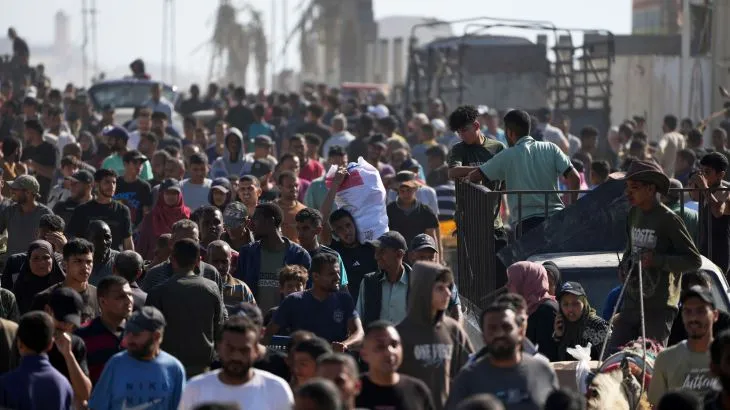In a shocking turn of events, large crowds stormed Israeli-backed aid distribution centres in Gaza today. The chaotic scenes underscored the gravity of the humanitarian crisis gripping the enclave, where residents are struggling to secure basic necessities amid ongoing military conflicts.
The aid distribution points, set up with international support to assist civilians impacted by the ongoing violence, found themselves overwhelmed with desperate individuals seeking food, medical supplies, and other essential resources. Eyewitnesses described scenes of pandemonium as hundreds, if not thousands, rushed to the locations, driven by the urgent need for survival.
The Humanitarian Crisis in Gaza
The situation in Gaza has long been marked by poverty and limited access to essential supplies. In recent months, as tensions between Israel and Palestinian militant groups have escalated, the situation has deteriorated significantly. According to reports from various humanitarian organizations, over two million residents of Gaza are facing acute shortages of food, clean water, and medical supplies.
The UN has frequently warned that Gaza risks becoming uninhabitable, stressing the need for immediate international intervention. The blockade and ongoing hostilities have severely restricted the flow of aid into the region, contributing to desperation among the civilian population.
The Storming of Aid Centres
Today’s storming of the aid distribution centres was reportedly characterized by chaos. Witnesses recounted how initial lines for aid quickly devolved into a frenzied rush as word spread that supplies were limited, prompting individuals to push their way forward in search of assistance.
“People were screaming and fighting for a place in line,” said Ahmed, a local resident who participated in the chaotic scenes. “We are all starving and have lost so much. When you see food, you do whatever it takes to get it.”
The Israeli and US-backed aid centres, established to provide support to civilians in need, have faced scrutiny regarding the checks that are supposed to be implemented to ensure that the aid reaches those it is intended for. Critics argue that the overwhelming needs of the population often overshadow these checks, resulting in desperate measures by civilians.
International Response and Concerns
As the situation escalates, international responses have varied. Some countries have condemned the violence and called for a ceasefire, while others have focused on the need for increased humanitarian assistance in Gaza. Human rights organizations are urging the international community to escalate their efforts to alleviate the suffering faced by innocents caught in the middle of the conflict.
The chaotic scenes at the aid centres have drawn attention to the urgent need for reform in how assistance is delivered to conflict zones. Critics of the current organizational structure argue that more efficient methods must be employed to ensure that aid reaches the most vulnerable populations. As tensions persist, it’s evident that reliance on traditional distribution methods may no longer be adequate.
Voices from the Ground
The perspective of the Palestinian residents living in the Gaza Strip is clear: many feel abandoned by the international community as they face what some describe as a living nightmare. The frustration became palpable during today’s chaotic distribution event, as residents grappled with complex feelings of anger, fear, and desperation.
“This is our reality every day,” said Fatima, a mother of three. “We are not just numbers; we are people with families and dreams. But all we see is death and hunger. What are we supposed to do?”
With access to basic supplies dwindling, families across the Gaza Strip are increasingly resorting to precarious means to survive. Reports of barter systems have emerged, with families trading goods and services in desperate attempts to meet their immediate needs.
Calls for Sustained Humanitarian Efforts
Humanitarian organizations are stressing the necessity for sustained efforts to provide ongoing assistance. “One-time distributions will never be enough to alleviate the pressure on these communities,” stated a spokesperson for an international NGO. “We need long-term solutions.”
The situation in Gaza remains critical. Efforts to provide aid must not only address immediate needs but tackle the systemic issues contributing to the humanitarian crisis. An effective response will require collaboration between international aid organizations, local authorities, and, most importantly, the communities they aim to assist.
A Path Forward
As gridlock persists and aid distributions continue to be met with chaos, many are left wondering how to move forward. The devastating reality on the ground in Gaza serves as a stark reminder of the human costs of conflict, the consequences of which extend well beyond the battlefield.
Today’s events will surely increase pressure on decision-makers to act swiftly and compassionately. The international community must commit to a more coordinated approach to humanitarian aid, ensuring it is delivered in a manner that prioritizes safety and nourishment for community members in need.
Conclusion
The storming of Israeli-backed aid centres in Gaza illuminates the profound desperation faced by civilians amid this ongoing humanitarian crisis. With each incident, the calls for urgent humanitarian assistance ring louder as the world watches helplessly.
A correct response to this tragedy requires recognizing the dignity of every individual affected, as well as the urgency of immediate on-the-ground action. Without a heightened response to the root causes of this humanitarian disaster, the staggering scenes of chaos witnessed today will persist, leaving countless families to endure suffering that no civilian should ever face.







